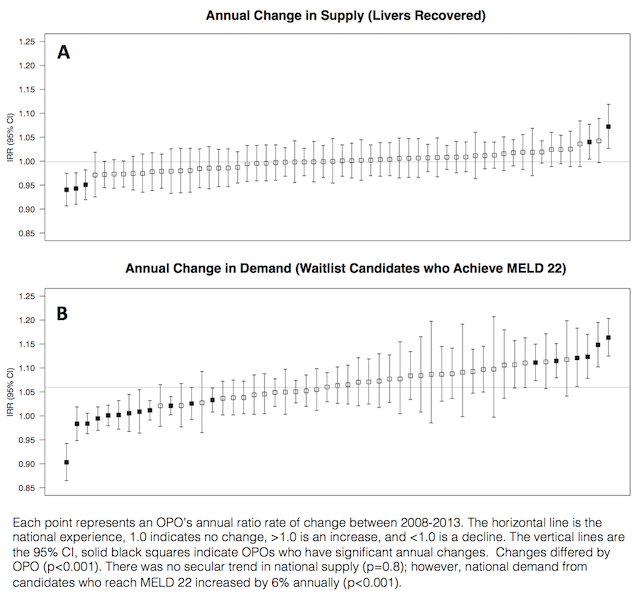Geographic Differences in Secular Trends of Liver Supply and Demand.
1JHU, Baltimore
2US Naval Academy, Annapolis
Meeting: 2017 American Transplant Congress
Abstract number: C194
Keywords: Allocation, Liver, Liver transplantation
Session Information
Session Name: Poster Session C: Organ Allocation, Meld Score, Organ Utilization, and Transplant Outcomes
Session Type: Poster Session
Date: Monday, May 1, 2017
Session Time: 6:00pm-7:00pm
 Presentation Time: 6:00pm-7:00pm
Presentation Time: 6:00pm-7:00pm
Location: Hall D1
Geographic disparities in access to deceased donor liver transplant reflect geographically disparate levels of supply of and demand for organs. Proposed policy changes like redistricting might be sensitive to secular trends in liver supply and demand.
METHODS We used SRTR data to study trends over the years between 2008 and 2013 in the OPO-level supply (livers recovered for transplant) and demand (waitlisted candidates who achieve a MELD of 6, 22, or 30) of livers. Liver supply and demand were modeled in multilevel Poisson regressions with random intercept/slope. Donor risk index (DRI) and the liver import rate were used as proxies of center aggressiveness in an OPO.
RESULTS There was no national secular trend in the number of recovered livers (IRR 0.999, p=0.8) with 6751 livers recovered in 2008 and 6775 in 2013. OPOs trended in different directions (p<0.001) ranging from 6% annual decline to 7% annual increase. Liver supply declined in 3 OPOs and increased in 2 OPOs (Figure 1A). There was no national secular trend in overall incident candidates (MELD≥6) (IRR 1.01, p=0.11); however there was a 6% annual increase in candidates who achieve MELD≥22 (p<0.001) increasing from 7173 in 2008 to 8728 in 2013. There was a 9% annual increase in candidates who achieve MELD≥30 (p<0.001). OPOs trended in different directions (p<0.001) ranging from 10% annual decline to 16% annual increase. Liver demand declined in 12 OPOs and increased in 6 OPOs (Figure 1B). OPOs with increased demand from MELD≥22 candidates were associated with increased DRI of livers transplanted (p=0.045), but were not associated with higher liver import rates (p=0.3).
CONCLUSION While liver supply and overall demand has been stable, there has been increasing liver demand from MELD≥22 candidates. Redistricting should account for secular increases as well as higher variance in liver demand across OPOs than liver supply. 
CITATION INFORMATION: Chow E, Choudhury R, Massie A, Gentry S, Segev D. Geographic Differences in Secular Trends of Liver Supply and Demand. Am J Transplant. 2017;17 (suppl 3).
To cite this abstract in AMA style:
Chow E, Choudhury R, Massie A, Gentry S, Segev D. Geographic Differences in Secular Trends of Liver Supply and Demand. [abstract]. Am J Transplant. 2017; 17 (suppl 3). https://atcmeetingabstracts.com/abstract/geographic-differences-in-secular-trends-of-liver-supply-and-demand/. Accessed December 14, 2025.« Back to 2017 American Transplant Congress
